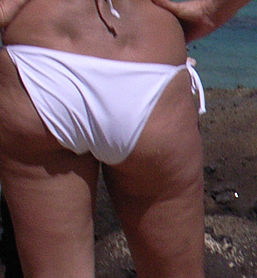- Cellulite
-
- This article is about the dimpled appearance of skin. For the infection of skin and its underlying connective tissue, see cellulitis. Not to be confused with Celluloid.
Cellulite Classification and external resources MedlinePlus 002033 Cellulite is a topographic skin change that occurs in most postpubertal females.[1] It presents as a modification of skin topography evident by skin dimpling and nodularity that occurs mainly in women on the pelvic region, lower limbs, and abdomen, and is caused by the herniation of subcutaneous fat within fibrous connective tissue, leading to a padded or orange peel–like appearance.[2] Cellulite is a description rather than a physical object.[3] The term was first used in the 1920s, and began appearing in English language publications in the late 1960s, with the earliest reference in Vogue magazine, "Like a swift migrating fish, the word cellulite has suddenly crossed the Atlantic."[4] Its existence as a real disorder has been questioned,[5] and the prevailing medical opinion is that it is merely the "normal condition of many women".[6] One cosmetic company has noted its historical place in industrialised societies as an "inappropriate term used by women to describe curves which they judge to be too plump and not very aesthetic".[7]
Synonyms include: adiposis edematosa, dermopanniculosis deformans, status protrusus cutis, and gynoid lipodystrophy. Descriptive names for cellulite include orange peel syndrome, and cottage cheese skin.
Contents
Epidemiology
Cellulite is thought to occur in 80-90% of postpubertal females.[8][9] There appears to be a hormonal component to its presentation. It is rarely seen in males,[2] but is more common in males with androgen-deficient states, such as Klinefelter's syndrome, hypogonadism, postcastration states and in those patients receiving estrogen therapy for prostate cancer. The cellulite becomes more severe as the androgen deficiency worsens in these males.[citation needed]
Causes
The causes of cellulite [10] involve changes in metabolism physiology and dieting too hard or too much, such as gender-specific dimorphic skin architecture, alteration of connective tissue structure, hormonal factors, genetic factors, the microcirculatory system, the extracellular matrix, and subtle inflammatory alterations.[1][2][10][11]
- Hormonal factors
Hormones play a dominant role in the formation of cellulite. Estrogen may be the important hormone to initiate and aggravate cellulite. However, there has been no reliable clinical evidence to support such a claim. Other hormones, including insulin, the catecholamines adrenaline and noradrenaline, thyroid hormones, and prolactin, are all believed to participate in the development of cellulite.[2]
- Genetic factors
There is a genetic element in individual susceptibility to cellulite.[2] Researchers led by Dr. Enzo Emanuele have traced the genetic component of cellulite to particular polymorphisms in the angiotensin converting enzyme (ACE) and hypoxia-inducible factor 1A (HIF1a) genes.[8]
- Predisposing factors
Several factors have been shown to affect the development of cellulite. Gender, race, biotype,[12] distribution of subcutaneous fat, and predisposition to lymphatic and circulatory insufficiency have all been shown to contribute to cellulite.[2]
- Diet
Improving one's diet, combined with exercise, can improve the appearance of cellulite.[citation needed]
- Lifestyle
A high stress lifestyle will cause an increase in the level of catecholamines, which have also been associated with the evolution of cellulite.[2]
Treatment
Numerous therapies for the treatment of cellulite are available, but empirical evidence for the efficacy of these strategies is limited[1]. In an interview with the New York Times, Dr. Molly Wanner, an instructor in dermatology at Harvard Medical School and an author of a 2008 evidence-based review of existing treatments, asserted: “At this point, there is no outstanding treatment for cellulite.”[13]
Dr. Michael F. McGuire, a clinical associate professor at the David Geffen School of Medicine at the University of California, Los Angeles, confirmed “realistically, there is no cure for cellulite.”[13].
References
- Notes
- ^ a b c Avram MM (December 2004). "Cellulite: a review of its physiology and treatment". J Cosmet Laser Ther 6 (4): 181–5. doi:10.1080/14764170410003057. PMID 16020201.
- ^ a b c d e f g Rossi AB, Vergnanini AL (July 2000). "Cellulite: a review". J Eur Acad Dermatol Venereol 14 (4): 251–62. doi:10.1046/j.1468-3083.2000.00016.x. PMID 11204512.
- ^ PINNA, K. (2007). Nutrition and diet therapy. Belmont, CA: Wadsworth. p.178
- ^ Vogue 15 Apr 1968 110/1
- ^ Nürnberger F, Müller G (March 1978). "So-called cellulite: an invented disease". J Dermatol Surg Oncol 4 (3): 221–9. PMID 632386.
- ^ MedlinePlus Encyclopedia Cellulite
- ^ Franchi J, Pellicier F, André P, Schnebert S (July 2003). "[The adipocyte in the history of slimming agents]" (in French). Pathol. Biol. 51 (5): 244–7. PMID 14567186.
- ^ a b Emanuele E, Bertona M, Geroldi D (2010). "A multilocus candidate approach identifies ACE and HIF1A as susceptibility genes for cellulite". Journal of the European Academy of Dermatology and Venereology 24 (8): 930–5. doi:10.1111/j.1468-3083.2009.03556.x. PMID 20059631. http://www3.interscience.wiley.com/cgi-bin/fulltext/123234684/HTMLSTART.
- ^ Wanner M, Avram M (April 2008). "An evidence-based assessment of treatments for cellulite". J Drugs Dermatol 7 (4): 341–5. PMID 18459514.
- ^ a b Pavicic T, Borelli C, Korting HC (October 2006). "[Cellulite--the greatest skin problem in healthy people? An approach]" (in German). J Dtsch Dermatol Ges 4 (10): 861–70. doi:10.1111/j.1610-0387.2006.06041.x. PMID 17010177.
- ^ Terranova F, Berardesca E, Maibach H (June 2006). "Cellulite: nature and aetiopathogenesis". Int J Cosmet Sci 28 (3): 157–67. doi:10.1111/j.1467-2494.2006.00316.x. PMID 18489272.
- ^ A population within a species that has distinct genetic variation.
- ^ a b New York Times, Treating Cellulite?
External links
 Media related to Cellulite at Wikimedia Commons
Media related to Cellulite at Wikimedia Commons
Categories:- Tissues
Wikimedia Foundation. 2010.

